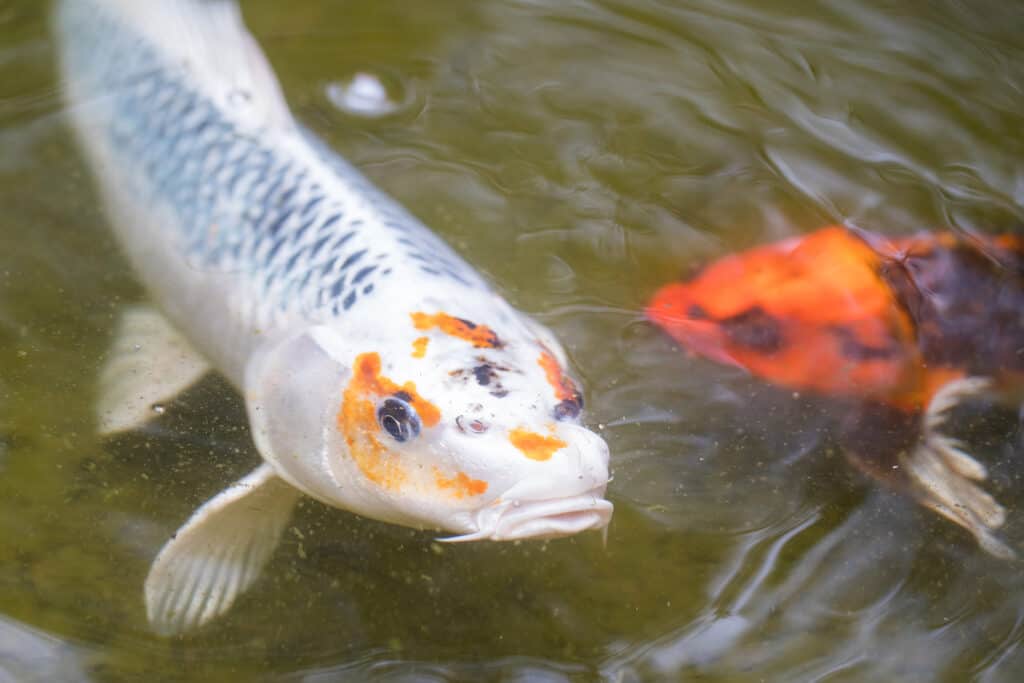
The keeping of koi fish has retained its popularity since its early beginnings in Japan. Hobby aquarists, restaurants, businesses, hotels, and many others keep koi in large ponds on their property. These fish are usually a bright array of colors, with fish of many different sizes in the same pond, but have you ever seen a giant of a koi and wondered, will large koi eat smaller koi?
Koi fish are opportunistic feeders, and although larger fish eat almost anything they can fit into their mouths, they do not eat smaller koi. Larger koi do, however, eat koi eggs and fry, as they are too small to distinguish from other food. As the fry grows, instances of cannibalism decrease.
As opportunistic omnivores, koi are renowned for their habit of eating whatever they can fit into their mouths. So why don’t larger koi eat smaller koi? Do all larger koi follow this behavior? Why do koi eat fry? What other food-related issues crop up when keeping koi of different sizes in the same pond?
Pro Tip: If you’re tired of wasting money and making costly mistakes on the koi-keeping hobby or are thinking about buying koi fish but don’t know where to start, I strongly suggest you check out this ebook. I recently read this ebook, and it contains SO much useful information, such as:
- 3 proven steps to identify koi fish diseases
- WARNING: 3 things you should NEVER do when it comes to caring for koi
- When to seek professional help when it comes to looking after your koi
Why Don’t Larger Koi Eat Smaller Koi?
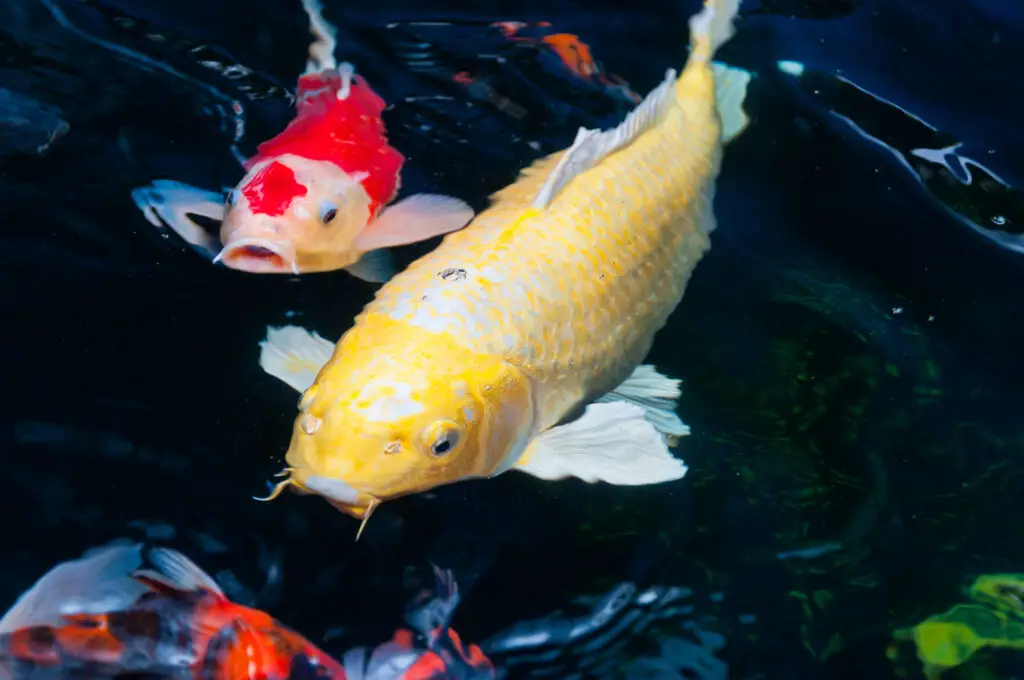
Koi fish, or Amur carp (Cyprinus rubrofuscus), are members of the expansive carp family (Cyprinidae) and they are well known for their vibrant colors, different personalities, and almost insatiable appetites.
Large koi will often eat smaller fish, like guppies, minnows, danios, and juveniles of other smaller fish species (anything that easily fits into the larger koi’s mouth). However, they will not eat juvenile or smaller-sized koi roughly 4 inches long (approximately a year old).
Most of the fish in the carp family are not actively cannibalistic when adults. Koi have been further domesticated to such a degree that they have a placid behavior, which results in not chasing down and eating other fish over a specific size.
Furthermore, many breeders agree that once juvenile koi become recognizable as koi, larger fish no longer pay them any interest as a potential food source.
When a koi pond provides the optimum conditions for its koi inhabitants, there is no reason for the fish to resort to cannibalism, as all their needs are met.
The same, however, cannot be said for koi fry.
Why Do Larger Koi Eat Koi Fry?
Although koi usually don’t eat fish greater than 4 inches, koi often eat eggs, newly hatched fry, and fry under 4 inches (including their species). This cannibalism means they are at risk of predation in the first year of their lives.
Some of the reasons why koi predate their fry include:
Koi Are Opportunistic Feeders
Although koi are widely regarded as “peaceful” fish, they are opportunistic omnivores, which means that if a koi can fit an animal or plant part/whole into its mouth, it will eat it.
In terms of animals, other fish are a frequently occurring food source in most pond situations. In the wild, a koi’s diet would consist of algae, insects, larvae, seeds, small crustaceans, worms, and anything else they can suck up during feeding.
Koi will readily eat eggs, newly hatched fry, and growing fry.
In many instances, a larger koi may not even actively “hunt” a fry/fingerling. The adult koi could be feeding in the area and “accidentally” swallow the juvenile fish along with whatever they were trying to eat.
Since domestication, koi are bred to eat at varying levels within the water column. However, carp are generally bottom feeders, sifting through mud, consuming organic matter, and frequently taste-testing whatever they find to determine if it is food or not.
Koi Eat Fry When Fry Are In Surplus
Koi need proteins and other nutrients for their survival. When a female koi lays eggs in the pond, she places thousands of energy-rich snacks in relatively easy reach for hungry koi. Once the eggs hatch, the larvae develop into fry and fingerlings; there are still hundreds to thousands of them within the water body, and therefore, in reach of the adult koi.
There may be an incredible surplus of fry and fingerlings in situations where multiple females lay eggs simultaneously. These tiny fish overpopulate the pond and frequently come across adult Koi, who gladly swallow the defenseless snack.
Koi Commercial Food Encourages Fry Predation
The most prominent ingredient in most store-bought fish food is fish. Many fish species are omnivores or generalist feeders, and fishmeal is a principal protein source.
For this reason, koi, and other fish, develop a taste for fish, so when they swallow fry, they have no issues with ingesting it, as they are familiar with the taste.
The Koi Pond’s Features May Encourage Koi To Eat Fry
These tiny fish (around 1 inch) could frequently “bump into “larger koi depending on pond size. These interactions don’t usually end very well for the fry.
A pond devoid of hiding spots (created by rocks and vegetation) also puts fry and fingerlings at greater risk of predation from larger koi.
Males Become Aggressive During Breeding
As with most cases of raised testosterone levels, male koi develop elevated levels of aggression. This aggressive behavior involves chasing the females around the pond and defending against other males.
During these high times of aggression, smaller koi (fry in particular) need to move away from larger males, as they are liable to be attacked and chased. It would not take much for a larger koi to eat fry during the excitement.
Do All Large Koi Eat Small Koi?
Not all larger koi eat fry. Rather, not all koi fry are eaten by large koi. Some hobbyists successfully breed their koi and raise their fry and fingerlings together in the same pond.
Very few isolated cases exist where a large koi eats a smaller koi. Some aquarists/hobby breeders have noted that during feeding time, larger koi become “excited” and, during the process of gobbling up food, accidentally swallow a smaller koi. These fish are very quickly spat out again by the larger koi.
Rarer still are the occasions where a larger koi consumes a smaller koi without spitting it back out.
Under What Circumstances Would Large Koi Eat Smaller Koi?
Although unlikely and exceedingly uncommon, certain circumstances might lead to a desperate case of predation.
Larger Koi May Cannibalize Due To Food Shortages
In the worst-case scenario, when there is a drastic food shortage, larger koi may resort to cannibalism. The smaller fish would still need to fit in the larger one’s mouth.
Adequate feeding of any animals in your care is a critical management component. If koi are left alone, with no food, they will consume all of the fry and fingerlings and potentially move onto smaller fish.
Although they are domesticated and considered peaceful, their survival instincts will still kick in, resulting in the survival of the fittest.
Overpopulation Of Koi May Lead To Cannibalism
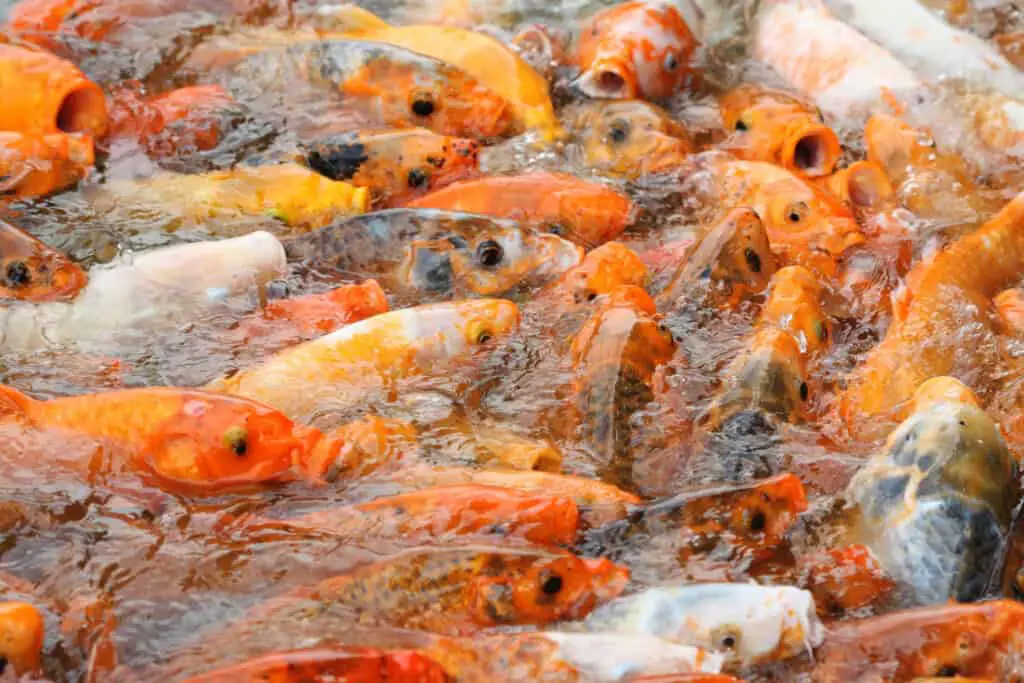
In situations of overstocking, where koi are left to breed, and the fingerlings and juvenile fish are not removed, a koi pond becomes overpopulated and passes the carrying capacity.
This overstocking results in competition over food sources, so even if you feed koi enough, not all fish will eat enough food, and hungry fish are inclined to look for other food sources.
What aggravates this matter is the lack of space for individual fish to move. Hungry fish cramped in an overcrowded pond, which results in poor hygiene conditions, become stressed. Stressed fish become aggressive and may attack other fish.
When smaller fish are involved, they are liable to be eaten if they are small enough to fit inside the larger fish’s mouth.
Sibling Cannibalism In Koi Fish
Yes, you read that correctly; researchers during a study in 1988 discovered that under the correct conditions, juvenile koi would eat their siblings.
Generally, sibling koi are more likely to eat one another when overcrowding occurs. This survival instinct reduces competition and provides the surviving sibling with the necessary nutrition in an overcrowded situation, where food distribution is inadequate.
Breeders have often noted sibling cannibalism. There are 16 recognized groups of koi comprising 100 different varieties. Some of the various phenotypes of koi fry grow quicker than others (the Benigoi variant and other darker solid-colored fish, for example).
As these fry grow, the larger ones may also feed on the smaller ones. This cannibalism enhances the growth rate of the surviving fish but reduces the color varieties available; therefore, breeders need to remove the cannibals quickly.
How Could You Prevent Larger Koi From Eating Smaller Koi?
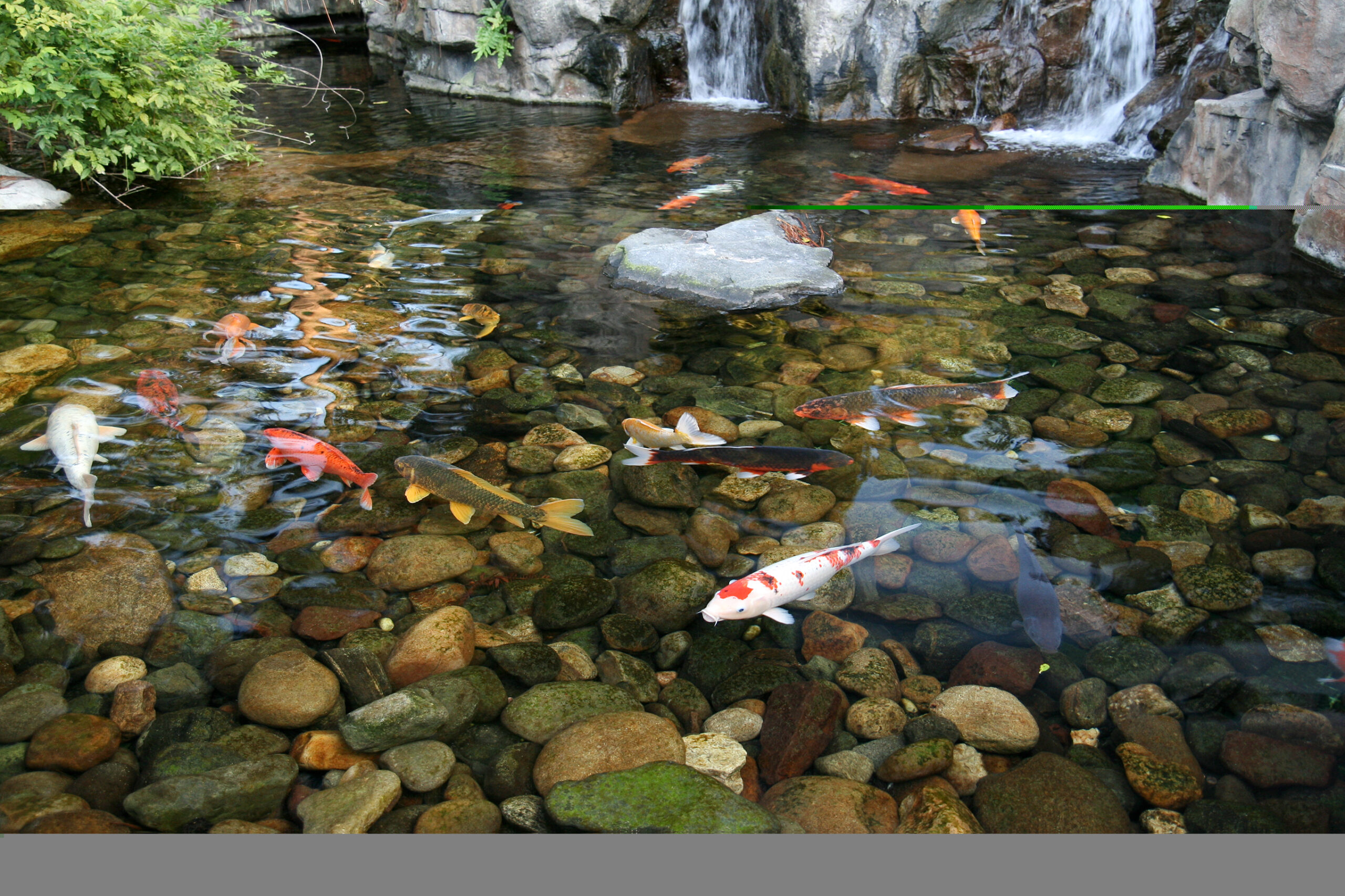
To reduce the likelihood and degree of larger koi predating fry and fingerlings, you can take some proactive measures.
Some of these measures include:
Larger Ponds Reduce The Likelihood Of Predation
Space is a huge concern for keeping koi fish. To successfully keep and breed koi, you require a large pond for all of the current and future adults. Alternatively, you would require a separate pond to move the new fish into.
One gallon of water per four inches of koi is a good guideline for determining stocking density and space requirements.
Prevention Of Breeding To Reduce Predation
If you are not wanting the headache and the hassle of dealing with population booms in your koi pond, the solution would be to ensure that you have an all-female (or all-male, but this may result in aggression as the males reach sexual maturity) pond.
Removing Eggs Clusters And Fry From Your Pond
If your koi are in a mixed tank of male and female fish, and you observe male koi chasing the females around the tank, there is a good chance that the females are ready to spawn, in which case you have roughly five days to remove the egg clusters before the baby koi hatch.
Koi usually lay their eggs on underwater vegetation and rocks in egg clusters. These clusters can be removed and transferred into a designated fry pond/tank to hatch and grow without the risk of predation from the adults.
Removing fry once they have hatched is not recommended as they are incredibly small and difficult to catch in an open pond environment. It is easier to collect and move as many egg clusters as possible before hatching.
Adding Breeding Partitions To The Pond
If space is a issue and you can’t move the eggs, placing net partitions in the pond creates “safe zones” for the fry and fingerlings to move into while keeping the adults away. These nets can sit just below the pond’s surface, so they do not become an eyesore.
Adding Decorations And Vegetation
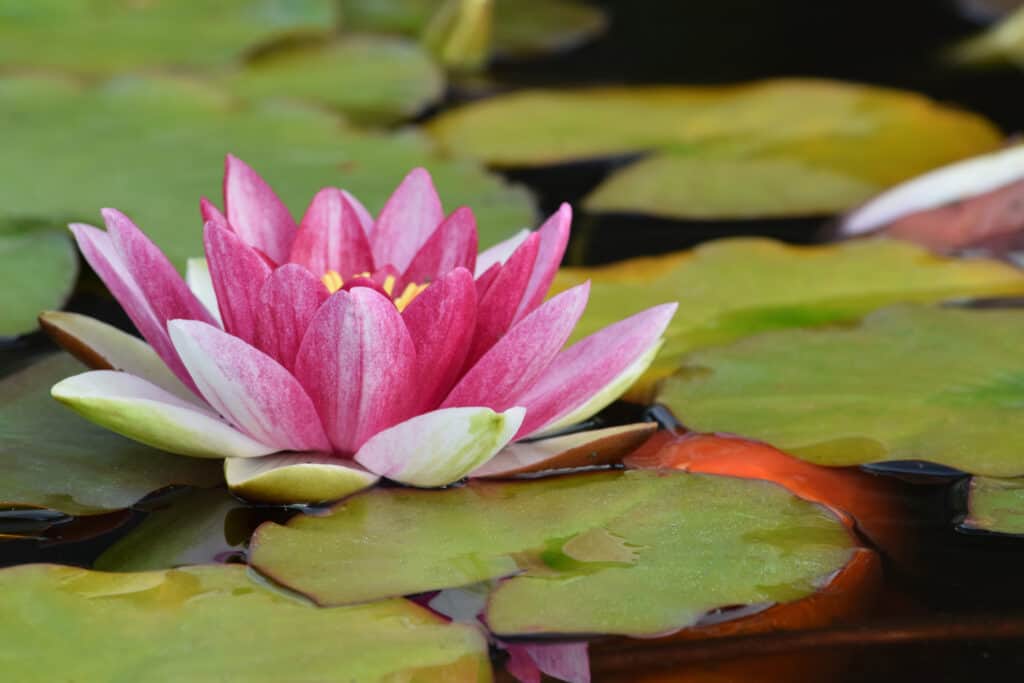

Most koi ponds should have these at any rate but ensuring sufficient rocks, underwater plants, and other decorations will create safe zones for your koi fry to hide in, away from hungry adults. These decorations are especially important if you do not put a net inside.
Creating a shallow area inside the pond is another way to assist fry and fingerlings who are small enough to fit in the shallows.
Proper Management Of A Koi Pond Is Essential
When you manage your koi pond well, you reduce the overall stress the denizens experience, improve their quality of life, and remain happy and healthy.
This effective management includes feeding regular high-quality food in controlled amounts. Making sure your koi are well-fed but not overfed is important. Feeding them too little will result in competition and increased predation. Feeding them too much will result in poor hygiene in the pond.
Aside from feeding koi sufficiently, a clean pond is the next important element. Clean ponds result in healthy fish that are not stressed. Another factor that reduces stress is not overstocking the pond.
Too many fish result in increased fry predation and potential injuries to adults. Ensuring that the ratio of females to males is also important for controlling aggression.
The purpose of managing a koi pond is to reduce the stress fish experience and to mitigate aggression. By managing, you reduce predation and create an environment where koi will cooperate.
Live And Let Live
A different approach allows the koi to “do as nature intended.” Large koi consuming fry and fingerlings provide a source of population control, and the adult koi receive nutrition simultaneously.
As bad as that sounds, fish-eating their young is not uncommon. It is one of nature’s ways of propagating natural selection. In a pond situation, it is a bit on the unethical side, but by ensuring, there are some hiding places, you provide some of the fry a fighting chance.
Other Feeding Issues When Large And Small Koi Are Together
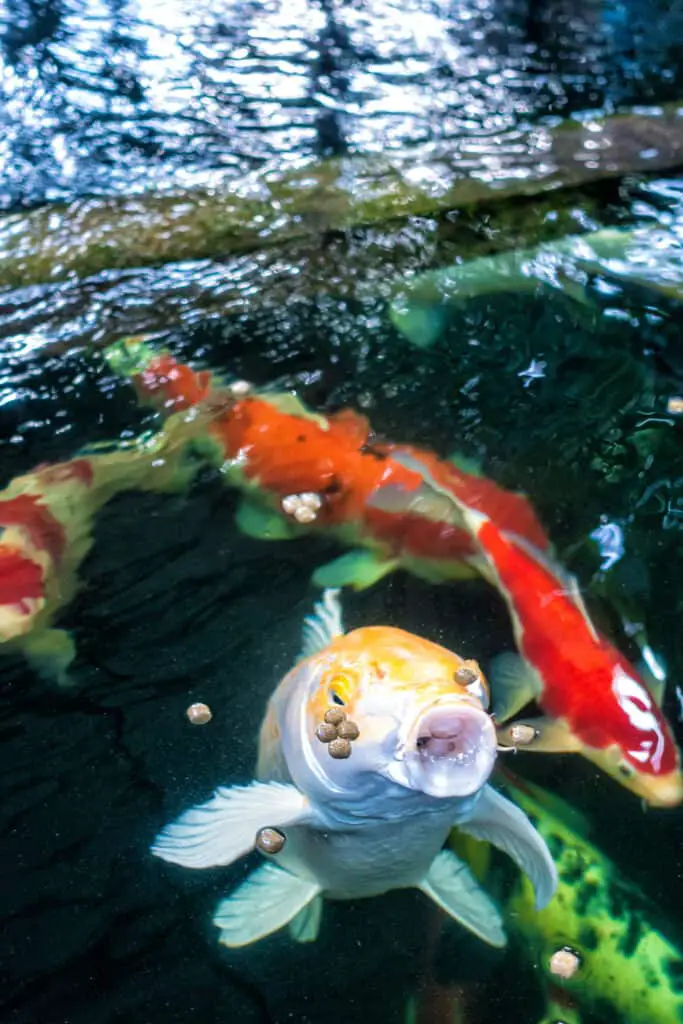
While larger koi are not likely to eat smaller koi unless the situation is dire, there are some other considerations of keeping different-sized koi together.
Larger koi may eat all the food, resulting in smaller koi starving. Koi don’t stop eating when they are “full,” so you may have a situation where larger fish eat their share, and because they are larger, bully smaller koi for their food as well.
When smaller koi are deprived of food, they do not grow as well and take a much longer time to grow at all. In drastic situations, it could even lead to the death of smaller fish.
Another issue experienced when keeping koi of different sizes together is that large koi food is not suitable for smaller koi. This situation is not difficult to rectify, but it is worth being aware of, as you need to change to a smaller-sized pellet, which large and small koi can eat.
Conclusion
Large koi eat their eggs and fry-sized babies. This predation is not uncommon among fish, nor is sibling cannibalism among baby koi. This predation tends to disappear once the fry resembles koi and is too big to fit into adult koi’s mouths. Only in particularly dire situations would a large koi actively hunt and eat a smaller koi. Adequate management and hiding places are required to protect the fry.


